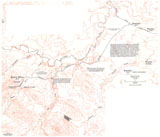The Kootenay and Alberta Railway
Development of Beaver Mines started in 1909 with the erection of some temporary buildings and the driving of a 1500-foot tunnel to reach a seam of coal. In 1910, a second tunnel to tap the same seam was dug across on the south-side of Beaver Creek. Continued development occured in 1911.1 On Febraury 7, 1911, the location plans for the railway were approved by the Board of Railway Commissioners and a Mr. L.B. Merriam, C.E., was put in charge to oversee construction. Grant Smith and Company, of Spokane, Washington, was engaged as the contractor.2 By June, Blairmore Enterprise3 could report that several hundered men, with the accompanying teams of horses were engaged in building the right of way. A steam shovel was used for the more difficult excavations. Construction was delayed principally due to wet weather and tracklaying into Beaver Mines did not occur until June 25, 1912.4 The estimated cost to build the line was $450,000.5There were two major wooden trestles, one over Lee’s Coulee and the other at Mill Creek. Smaller ones were found at McLaren’s Coulee and Beaver Creek. The company owned one, and possibly two, locomotives and a passenger coach. The coal was transported in cars supplied by the Canadian Pacific Railway.
In 1913 as the result of the consolidation of four collieries, the WC&CC became part of the Canadian Coal and Coke Company with head offices in Montreal. By 1914, the District Mine Inspector reported that “very little work is being done at the [remaining] mine, only five or six days per month.”6 The output was 250 tons per day extracted in three shifts by 78 men and 5 horses. On March 26, 1915, the mine was closed. By January, the properties and assets (including the charter of the Kootenay and Alberta Railway) were vested in The North American Collieries Ltd., which in June 1917 had men dismantaling machinery and buildings, and work crews repairing the track. Once the material had been removed the rails were lifted and the trestles torn down.
Notes | Bibliography | Abbreviations
1. Alberta Department of Public Works, Annual Reports 1909-11.2. The Railway and Marine World, May 1911.
3. The Blairmore Enterprise, 15 June 1911.
4. Babian S. (Compiler), The Coal Mining Industry in the Crow’s Nest Pass, p. 94.
5. Public Archivs of Alberta PA 77.237/199a.
6. Public Archivs of Alberta PA 77.237/199b.


